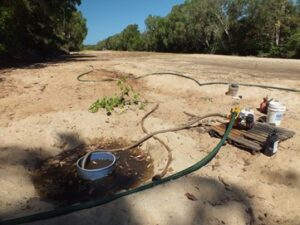Executive Summary
For over a decade the Lama Lama people of Port Stewart, Far North Queensland, have been struggling to get a reliable supply of water since their original water intake was destroyed by a cyclone in 2006. Arup has been working with the Indigenous organisations Yintjingga Aboriginal Corporation (YAC), the Centre of Appropriate Technology Ltd. (CfAT Ltd.) and EWB Connect to, on a pro-bono basis, design a safe, robust and reliable supply of water for the Indigenous community to enable them to source funding for the new intake and treatment system.
Since 2006, the community has been using a portable petrol pump to extract untreated water from the Port Stewart River. The improvised arrangements are unreliable and prone to contamination. The design of the intake and treatment system was required to meet the local constraints, including: no services; minimum maintenance; suitable for non-technical community; low ongoing costs; resilience to bushfires, extreme heat, cyclones and flooding.
Such constraints required innovative and appropriate design solutions, extensive stakeholder engagement, as well as financially, environmentally and socially sustainable outcomes. The design uses solar-powered submersible bore pumps to retrieve water from below the bed sands of the river. A low-maintenance aeration filtration system, which is chemical-free and uses no electricity, will remove the high levels of iron from the raw water source. Solar powered UV is proposed to treat the water for E.Coli.
The design has enabled CfAT Ltd and YAC to raise over $250,000 in funding. With safe and reliable water, the community will be able to pursue new economic opportunities.
Related SDGs:
3 – Ensure healthy lives and promote well-being for all at all ages
9 – Build resilient infrastructure, promote inclusive and sustainable industrialisation and foster innovation
13 – Take urgent action to combat climate change and its impacts
16 – Promote peaceful and inclusive societies for sustainable development, provide access to justice for all and build effective, accountable and
Background
For over a decade the Lama Lama people of Port Stewart, Queensland, have been struggling to get a safe and reliable supply of water since their original water intake was destroyed by a cyclone in 2006, impacting the health of the indigenous community. Arup has been working with partners to, on a pro bono basis, design a safe, robust and reliable supply of water for an Indigenous community.
Challenges
The key challenge in the design process was finding a sustainable, appropriate technology for the complex environment and community requirements. In this scenario, it was important for the technology to be selected to meet the technical and financial capability of YAC to operate and maintain.
Another challenge was the lack of design inputs, for example geotechnical information, surveys and regular water sampling data. This resulted in the design being built upon various assumptions, rudimentary site surveys by the team, coarse GIS data, local community member knowledge and local contractors.
Solutions and Stakeholders
Design solutions include solar-powered bore pumps, a low-maintenance aeration filtration system and solar powered UV. The critical success factor to overcoming the design challenges, was regular engagement with the Indigenous organisations and building a strong, long term relationship with partners, including CfAT Ltd and YAC. This ensured the design was suitable for the community and appropriate training would be provided so they could maintain the system over time. Keeping the requirements of the community front of mind, and using an iterative design process, including regular communication, ensured that the end design solution was acceptable to the community and met key requirements
Results
• The design solution was developed using an iterative design process which was particularly important to overcome the lack of data available, as it enabled the design to incorporate local knowledge.
• The design uses solar-powered submersible bore pumps to retrieve water from below the bed sands of the river. A low-maintenance aeration filtration system, which is chemical-free and uses no electricity, will remove the high levels of iron found in the raw water source. The future addition of a UV disinfection system powered by solar and batteries, which has been incorporated into the design, will be used to further reduce microbial risks to the water supply.
• The design was completed in July 2017 and has enabled CAT Ltd and YAC to raise over $250,000 in funding, enough to build the new infrastructure.
• “When the new infrastructure is installed, we will have something everyone else in Australia takes for granted – a reliable water supply,” Gavin Bassani, Operations Manager, Yintjingga Aboriginal Corporation.
• With safe and reliable water supply, the Lama Lama people will be able to pursue new economic opportunities.
How to Replicate
The critical success factors, necessary to replicate to when designing for similar remote communities, where community members are responsible for the operations and maintenance of the water supply include:
• Working with partners closely and collaboratively is imperative to ensure that solutions are appropriate and the needs of the community are represented accurately.
• The technical solutions are scalable for larger communities
• Designing for the locational needs and constraints, prioritising appropriate technology and self sufficiency of the community
References
Arup. (2017). Port Stewart Water Supply Upgrade – New intake and water treatment system: Drawing set. Melbourne: Arup.
Centre of Appropriate Technology, Ltd. . (2013). Photographs of existing system.
Engineers Without Borders Australia. (2011). Port Stewart Water Supply: Status Report. Melbourne: Engineers Without Borders Australia.
Fitzgerald, S, Silvester, K, Heslop, E, McGill, G (2018). One Size Doesn’t Fit All: Scaling Water Solutions to Achieve the Global SDGs. Melbourne: OzWater, Australia.
Infinity Environmental . (2015). Operation and maintenance instructions for: The infinity iron removal filter. Alexandria, NSW: Infinity Environmental .
Reaqua. (2017). Port Stewart Qld solar pumping project: Submersible pump system. Lonsdale, SA: Reaqua.
This case study is the result of the SDG Taskforce work on collecting case studies about how IWA (corporate) members are catalysing action to achieve the SDGs. Click here to connect to the SDG Taskforce


